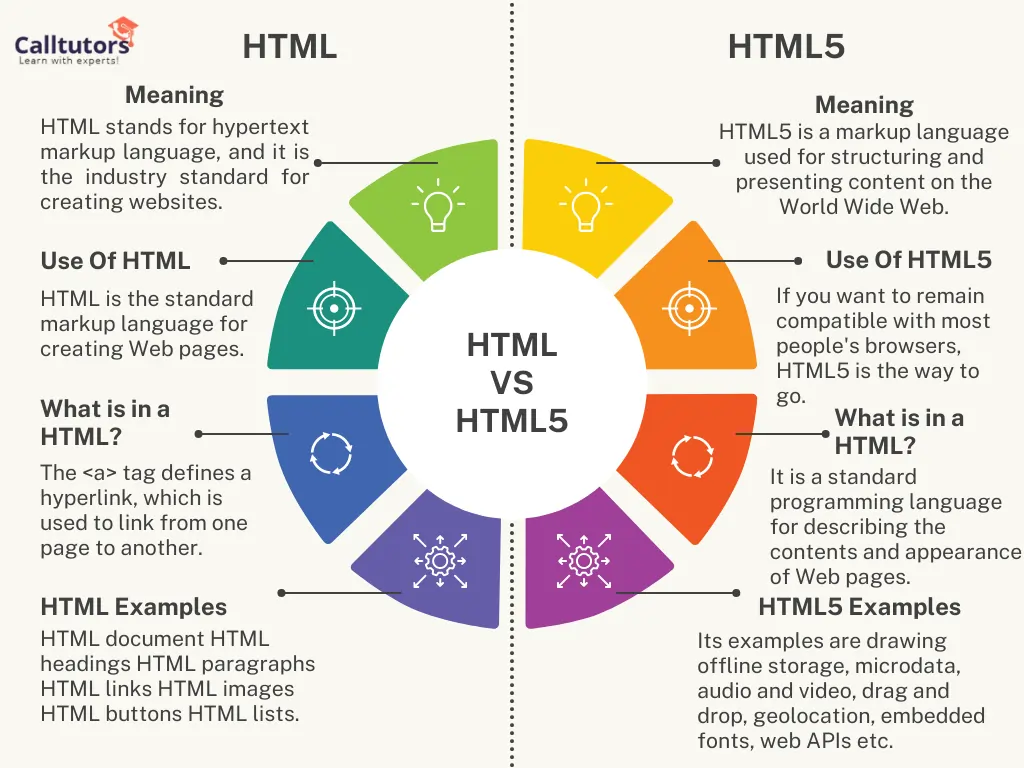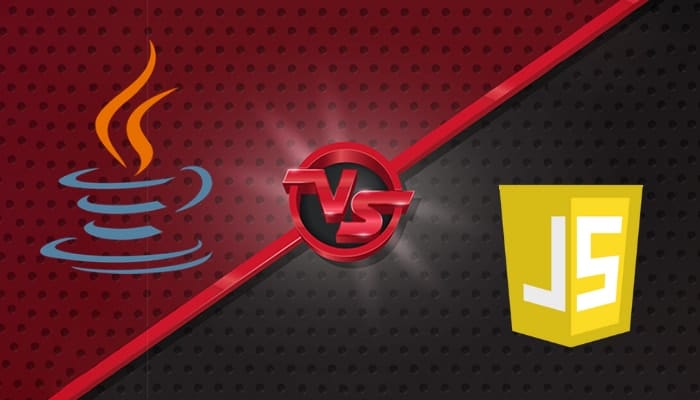Want to know about comparisons between HTML Vs HTML5? How has HTML been made more advanced with its latest version? Why do Students prefer to choose HTML5? Let’s know here which is better to choose.
Usually, HTML was the modest programming language of the world. Sir Timothy John Berners-Lee was making his first elementary and authoring system for the web. He was creating the quickest little hypertext language to serve his main goal. Apart from this, Tim Berners-Lee imagined dozens of hypertext formats and exclusive clients. It could be easily translated and negotiated documents from servers.
Generally, HTML is one of the best standard markup languages that is used for creating web applications and web pages. It’s also used for describing the structure of web pages using markup.
On the other hand, HTML5 is the advanced version of the programming language that was developed by WHATWG. The main reason behind the investigation of it is that it resolves the compatibility issues of HTML4. Let’s know the main differences between HTML and HTML5 below.
What is a Markup Language?
Table of Contents
Annotating a document with a markup language is a system design. So that markup language can be syntactically distinct. Tags are used to define items in the markup language. It includes phrases and words in the English language. As a result, they’re easy to understand. Markup languages are specifically designed for the processing, definition, as well as presentation of text.
What is HTML?
The language used for the www is HTML (world wide web). HTML is a text formatting language that is used to construct and display web pages.
HTML files consist of two things 1) tags and 2) content formatting it for proper display on pages. Cascading Style Sheets (CSS) and scripting languages like JavaScript can be used by technologies. Hypertext markup language (HTML) stands for hypertext markup language. HTML is also known as HTML v 1.0.
What is HTML5?
It is the fifth version of HTML 1.0, and it now supports more tags and functionalities. Technically, its HTML version is 5.0, however it is most commonly referred to as HTML5.
The latest versions of browsers such as Safari, Opera, Chrome, and Firefox support all the features of HTML5. A web developer can use HTML5 to develop photo sites, web forums, and advanced mapping applications. Hypertext Markup Language (HTML5) is another name for HTML5.
Features of HTML
- platform-independent language.
- It is not a delicate dialect.
- You can control font, colors, as well as position using cascading style sheets.
- We can create tables.
- Enhance the presentation of a page using an HTML element.
- Enables you to grow a web page using tags.
- Use graphics and also display text in different fonts, sizes, and colors.
- HTML helps you to create hyperlinks to navigate different documents that exist on the web.
- You could display data in tabular format.
- Build more than one window in a web page to display information from several sources in different windows.
Features of HTML5
- It supports local storage.
- HTML5 has new content related elements, such as, <foot>,<header>, <article>, <naval>, <section> etc.
- This new look provides control, such as date, calendar, time, URL, email, and search.
- <Canvas> element for creating two-dimensional diagrams
- Support for CSS3 and a new version of CSS.
- It provides support to the media.
- The Figure element can be combined with other image elements to easily add elements to a caption.
- You could store high amounts of data locally without affecting the performance of the site.
- It is capable of handling incorrect syntax.
What is the difference between HTML VS HTML5?
There are many differences between HTML VS HTML5:
| HTML | HTML5 |
| With the use of and tags, it is possible to manage video and audio. | Cookies are used by HTML to store temporary data. |
| To store data offline, it makes use of a SQL database and an application cache. | To store data offline, it makes use of a SQL database and an application cache. |
| JavaScript isn’t allowed to run in the browser. | JavaScript can now run in the background thanks to HTML5. It’s feasible thanks to HTML5’s JS Web Worker API. |
| Vector graphics can be used in HTML using a variety of technologies such as VML, Silver-Lite, Flash, and others. | SVG and canvas, as well as HTML5, include vector graphics as well. |
| Drop and drag effects are not allowed in HTML. | Drop and drag effects are supported by HTML5. |
| Shapes like circles, rectangles, triangles, and others are not possible to draw in HTML. | Shapes such as circles, rectangles, and triangles can be drawn using HTML5. |
| HTML is compatible with all older browsers. | All new browsers, including Mozilla, Firefox, Safari, Chrome, and others, support it. |
| The old version isn’t as mobile-friendly as the new one. | HTML5 is a mobile-friendly language. |
| The doctype statement is too lengthy and puzzling. | The doctype statement is straightforward and straightforward. |
| There were no navigation or header elements. | A new element for web structure like as headers, navigation, and footers, among other things. |
| Character encoding is a time-consuming and difficult process. | Encoding characters is basic and straightforward. |
| Obtaining the user’s true GeoLocation using a browser is practically impossible. | The JS GeoLocation API may be used to simply track a user’s GeoLocation. |
| HTML is unable to deal with erroneous syntax. | It is capable of coping with incorrect syntax. |
| HTML lacks attributes like ping, charset, and async. | HTML 5 includes attributes such as ping, charset, and async. |
Which Components Changed Of HTML By HTML5?
HTML5 has changed or eliminated a number of HTML components. The following are a few of them:
| Element | In HTML5 |
| <dir> | Changed to <ul> |
| <frame> | removed |
| <frameset> | Removed |
| <noframes> | Removed |
| <applet> | Changed to <object> |
| <acronym> | Changed to <abbr> |
| <big> | No new tag. CSS is used for this |
| <strike> | No new tag. CSS is used for this |
| <font> | No new tag. CSS is used for this |
| <basefont> | No new tag. CSS is used for this |
| <tt> | No new tag. CSS is used for this |
| <center> | No new tag. CSS is used for this |
What are the advantages of HTML VS HTML5?
There are many differences between HTML vs HTML5:
Advantages of HTML:
- Easy to use for developing web pages
- Create a web document easily
- It helps you navigate within web pages and between websites located on various servers.
- In HTML, you can set up queries to use responsive images.
- The user cannot save browser data that persists throughout the session.
- Once the data is stored in the browser, the developer can think ahead to make the application work.
Advantages to HTML5:
- It has capabilities such as a large set of new APIs about file systems, client-side storage, event handling, and more.
- Easy to create a new interactive website.
- Because HTML5 takes a practical approach, you can easily fix real-world problems.
- This has simplified Doctype and character sets.
- HTML5 provides elements such as <details>, <dialog>, <sign>, and more.
- HTML5 has improved web forms with a new feature for the <input> tag.
- It gives consistent local storage to achieve without using any third-party plugins.
- It has a WebSocket, a next-generation communication technology for web application development.
- HTML5 introduces events known as server-centered events (SSEs).
- This simplified the markup
- Two-dimensional drawing surface support that you can program with JavaScript.
- HTML5 enables you to create your terminology.
- You can create your custom semantics.
What are the disadvantages of HTML VS HTML5?
There are many differences between HTML vs HTML5:
Disadvantages of HTML:
- HTML does not help in creating dynamic pages. It can only create plain pages.
- You may need to write a long code to create a simple webpage.
- HTML lacks adequate security mechanisms.
- It takes time to develop anything, even resembling a webpage.
- HTML is not as flexible as developing other web pages such as Dreamweaver.
- It is not following a centralized approach. It would help if you edited the web pages separately.
Disadvantages of HTML5:
- A modern browser is required to access it.
- There are issues related to media licensing.
- Multiple device responsiveness can become a headache.
- The HTML5 language is still in progress.
- Gaming conflicts with JavaScript and HTML5.
- There are no good IDEs available in HTML5.
What is the key difference between HTML VS HTML5?
There is the most important difference between HTML vs HTML5:

- HTML is not supported in video and audio, whereas HTML5, video, and audio are integrated into it.
- HTML is supported by nearly all browsers, while HTML5 is supported by the majority of current browsers, such as Firefox, Mozilla, and Chrome.
- Other HTML tools, such as Silver Light, Flash, and others, allow vector graphics. Default supported HTML5 vector graphics, but it also includes canvas and SVG.
- In HTML5, the applet tag remove, used to display the applet, and an object tag is introduced whereas the applet tag uses in HTML.
- In HTML, the tag may refer to both an anchor and a link, however in HTML5, the element uses as a tag.
- The tag was used to display the abbreviation in HTML, but in HTML5, the tag has been replaced by the tag, which will serve the same purpose.
- HTML is incapable of addressing problems such as improper syntax and other issues, however HTML5 can.
- While we can have numerous attributes in HTML5, the element can only have one attribute range and the value in HTML must be zero or one.
- In HTML, communication between server and client will occur using streaming and long pooling as it does not have support for sockets, while HTML5 has support for web sockets through which full-duplex communication between client and server is possible.
conclusion
Lastly, it is an overview of the differences between HTML vs HTML5. After reading this HTML and HTML5 article, you will have a better understanding of HTML and HTML5. HTML5 would be useful for web developers as it offers many capabilities such as video and audio support, new tags, and elements. The W3C also announced that a future update to HTML5 would focus on privacy tools. Gradually all web developers are moving to HTML5 because it has more specifications than the previous HTML version. and also if you need with HTML homework tasks then contact our experts.
Frequently Asked Questions
Why are we using HTML?
HTML allows users to create and structure sections, headings, links, paragraphs, and more, on a website using various tags and elements.
Is HTML5 easy or hard?
HTML5 is a relatively easy coding language to learn the basics of. However, like all programming, the overall difficulty will depend on each learner’s experience, etc.
Are we still using HTML5?
Likewise, older browsers can “overlook” new HTML5 code while rendering content. All modern browsers, including Chrome, Firefox, Mozilla, Opera and Safari, now support HTML5 specifications fairly well.



